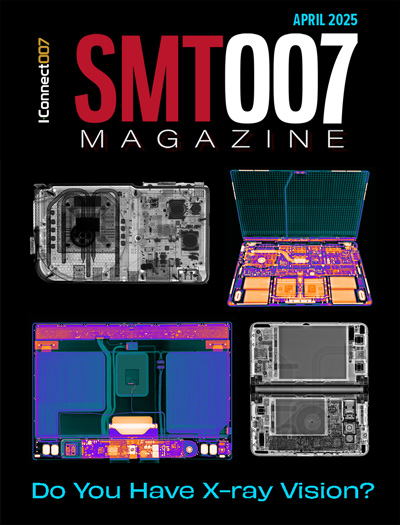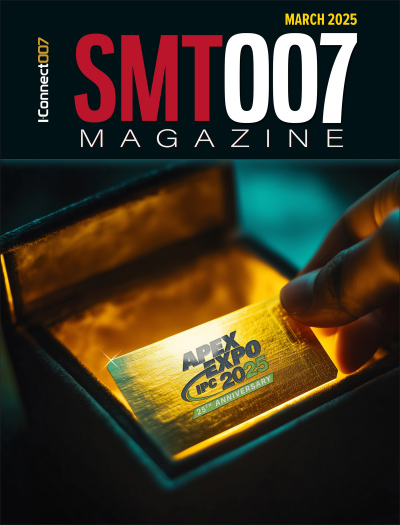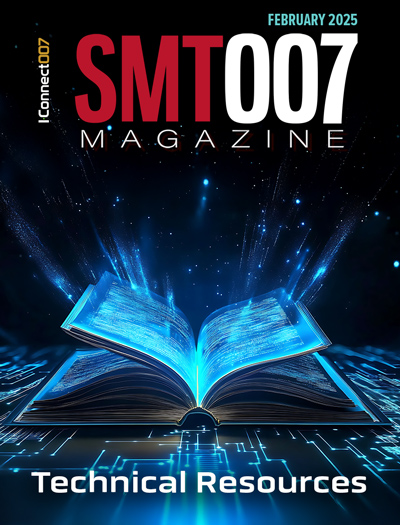-

- News
- Books
Featured Books
- smt007 Magazine
Latest Issues
Current Issue
Do You Have X-ray Vision?
Has X-ray’s time finally come in electronics manufacturing? Join us in this issue of SMT007 Magazine, where we answer this question and others to bring more efficiency to your bottom line.

IPC APEX EXPO 2025: A Preview
It’s that time again. If you’re going to Anaheim for IPC APEX EXPO 2025, we’ll see you there. In the meantime, consider this issue of SMT007 Magazine to be your golden ticket to planning the show.

Technical Resources
Key industry organizations–all with knowledge sharing as a part of their mission–share their technical repositories in this issue of SMT007 Magazine. Where can you find information critical to your work? Odds are, right here.
- Articles
- Columns
Search Console
- Links
- Media kit
||| MENU - smt007 Magazine
The Benefits of Vapor Phase Reflow Soldering
May 3, 2023 | Barry Matties, I-Connect007Estimated reading time: 3 minutes
JB Byers, vice president of technical support services at A-Tek Systems in Longmont, Colorado, recently gave a presentation on vapor phase reflow soldering at the SMTA Boise Expo & Tech Forum. After his presentation, I-Connect007 briefly talked with him about how the process can help reduce voids and lower operating cost.
Barry Matties: In your session on vapor phase reflow soldering, you did a great job of explaining how you're able to eliminate voids through a vacuum in the process. Talk to us about that and its other benefits.
JB Byers: With power or structural applications, if you don’t have the right amount of solder designed by the engineers, you don’t get the structure, energy, or heat transfer that’s necessary. While the solder is under a liquidous condition, the vacuum process within the reflow of vapor phase, reduces the voids that can overcome those problems had the voids been left in. When you reduce the atmospheric pressure around the voids, it causes them to grow and break the surface tension of the liquid solder bubble. As you return them back to atmospheric pressure, the voids are dramatically reduced.
Matties: We're now seeing some alternate technologies, like laser technology. How would this compare?
Byers: They all have a specific role to fill. I like the vapor phase because it's fairly broad on what it covers. It is a great technology for manufacturers that struggle with the convection oven due to dissimilar sizes, material board layouts, etc. In a vapor environment, the applied heat and energy to the board is very homogeneous and very even throughout the board.
Matties: All things are equal.
Byers: Yes, and that's a real benefit. With a convection oven and some of your larger heatsinks, it takes a lot of energy to get them up to temperature and to reflow the solder. By the time they're at temperature, the small surface mount components around them may have dramatically overheated.
Another benefit of the vapor phase is that the maximum temperature—the boiling temperature of the fluid—is limited. No matter how long you’re in the reflow chamber of a vapor phase, the maximum temperature your board will reach is 230°F.
Matties: The temperature doesn't continue to climb.
Byers: That’s right.
Matties: Interesting. How widely used is the vapor phase?
Byers: It's growing in the United States because, in my opinion, we've actually decided to start making things here again. We're bringing back a lot of production lines. Throughout my 30 years in this industry, I watched production lines continually move away every year, but I believe their numbers have increased in the last two years—for the first in a very long time.
Matties: Why hasn't this technology been adopted on a wider scale?
Byers: It is growing, but because many of these products are easy to manufacture, there's no reason to change from convection.
Matties: Is this for more high-end medical, high reliability?
Byers: Mostly high reliability. The big players are starting to look at it from the technology side.
Matties: The cost of utilities has gone through the roof. Does this lower the cost?
Byers: Yes. Typically, a vapor phase will use less than a third of the energy than a standard convection oven uses. With vapor phase, we only need to create energy when we're actually reflowing boards. When we're not doing that work, we set it at a very low boiling temperature, the minimal amount of energy. If we need energy, we create it. That’s unlike convection ovens, where all zones maintain heat at the same time.
Matties: What will prompt more exploration of this, particularly when the infrastructure is already in place and it's hard to pull something that's generally working.
Byers: We see customers want to upgrade their processes. Many of them are well aware of vapor phase and are looking to learn more.
Matties: Is this an automated process? Does it require a certain skill set?
Byers: Only a minimal skill set is needed. Maintenance technicians need a general understanding of, for example, reading schematics—lefty loosey, righty tighty. Process engineers can be trained to operate the machines and certain features of its software.
Matties: In today's world, data collection, statistical process control is a factor. I'm sure you have traceability.
Byers: Yes, we can download, dump data, or whatever is needed.
Matties: JB, thank you very much. This has been very informative.
Byers: Thank you.
Suggested Items
KYZEN Focuses on Aqueous Cleaning and Stencil Cleaning at SMTA Wisconsin
04/24/2025 | KYZEN'KYZEN, the global leader in innovative environmentally responsible cleaning chemistries, will exhibit at the SMTA Wisconsin Expo and Tech Forum, scheduled to take place Tuesday, May 6 at the Crowne Plaza Milwaukee Airport. KYZEN will be on-site to provide attendees with information about aqueous cleaning chemistry AQUANOX A4618 and stencil cleaner KYZEN E5631J.
SMTA Bridging the Skills Gap in Arizona
04/24/2025 | Marcy LaRont, I-Connect007One area where SMTA really excels is through its local chapters. On April 16, 2025, I-Connect007's Marcy LaRont attended the Workforce Breakfast during the SMTA Arizona Expo & Tech Forum in Mesa, which featured more than 50 electronics professionals from the local area, including defense OEMs, and others who were attending for the first time. Blackfox and Hyrel Technologies sponsored the event. The keynote presentation featured Sean Denny, a professor at Estrella Mountain Community College, who emphasized a clear need for skilled hand soldering technicians.
IPC Releases Version 2.0 of IPC-2591, Connected Factory Exchange, with Expanded Device Coverage and Smarter Data
04/23/2025 | IPCIPC announces the release of IPC-2591, Connected Factory Exchange (CFX), Version 2.0, the global standard for plug-and-play, machine-to-machine, and machine-to-system communication for digital manufacturing.
ViTrox Marks 25 Years of Innovation with Cutting-Edge Solutions at NEPCON China 2025 in Shanghai
04/18/2025 | ViTrox TechnologiesViTrox, which aims to be the World’s Most Trusted Technology Company, is proud to announce its participation in NEPCON China 2025, taking place from April 22–24, 2025, at Booth #1E45, Shanghai World Expo Exhibition & Convention Centre (SWEECC).
Indium Experts to Present on Power Electronics at PCIM Europe 2025
04/17/2025 | Indium CorporationAs one of the leading materials providers to the power electronics assembly and e-Mobility industries, Indium Corporation experts will share their technical insight and knowledge on a variety of industry-related topics throughout PCIM Europe, May 6-8, in Nuremberg, Germany.


